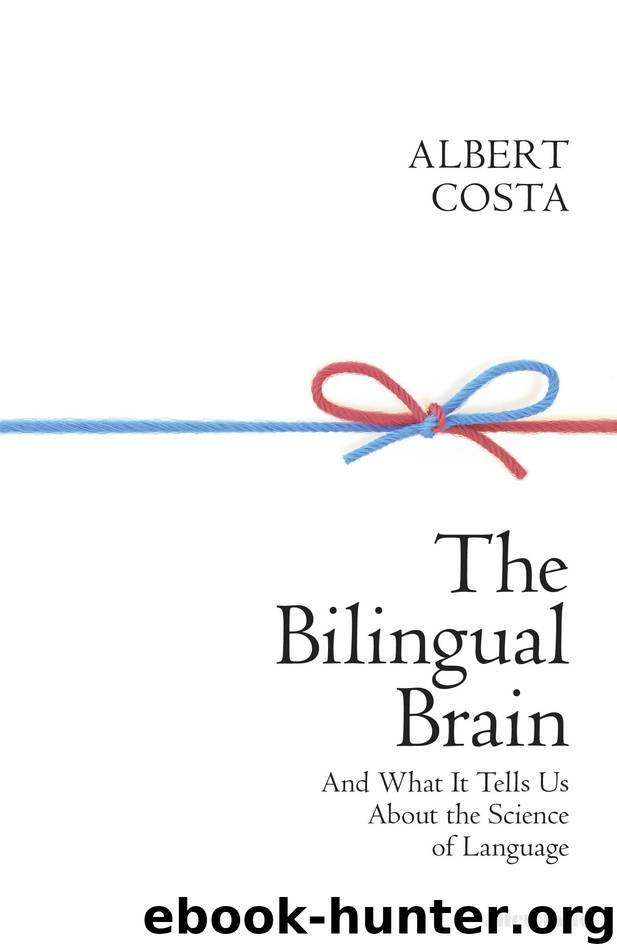The Bilingual Brain by Albert Costa

Author:Albert Costa [Costa, Albert]
Language: eng
Format: epub
ISBN: 9780241391525
Publisher: Penguin Books Ltd
Published: 2019-11-08T00:00:00+00:00
These findings have to be interpreted with care and, as you can imagine, they are the perfect ammunition for those who are against bilingual education. First, we have to look at how large the difference is in vocabulary for bilinguals and monolinguals, something we call the magnitude or effect size. Let me explain: imagine that we take a cold medicine that, according to proven studies, shortens the duration of the symptoms. In other words, when we randomly administer this medicine to one group of patients and a placebo to another group, the symptoms of the cold generally disappear earlier in the first group compared to the second. Perfect; we’re convinced, let’s go buy the medicine. But wait a minute. Ask yourself how much the symptoms are reduced, that is, consider not so much whether the medicine is effective, but just how effective. If it turns out that the symptoms will last two days less, you may want to buy the medicine, but if they will only last two hours less, you may want to think again (after all, you will have a cold for almost the same time with or without the medicine). With vocabulary reduction, the same thing happens: the result of the test from the aforementioned study has an average of 100 and a standard deviation of 15. This basically means that the majority of children score between 85 and 115. But what is the average of bilingual children? Between 95 and 100. And that of monolinguals? Between 103 and 110. That is to say, all are very close to the average of the general population. Therefore, it is true that there is a reduction in the size of the vocabulary associated with bilingualism, but this is relatively modest.
On the other hand, we may be tempted to apply the group norm to particular individuals and think, for example, that if our child grows up in a bilingual environment, his vocabulary will necessarily be smaller than if he grows up in a monolingual environment. Stop right there; applying a group norm to an individual is inappropriate and, in this specific case, even less so. Let’s look at Figure 3.3, which shows the distribution of scores for bilingual and monolingual children on a vocabulary test. On the horizontal axis we find the test scores, and on the vertical axis we see the percentage of children who obtained those scores.
Figure 3.3. Distribution of vocabulary scores for bilingual and monolingual speakers.
Download
This site does not store any files on its server. We only index and link to content provided by other sites. Please contact the content providers to delete copyright contents if any and email us, we'll remove relevant links or contents immediately.
| Administration | Assessment |
| Educational Psychology | Experimental Methods |
| History | Language Experience Approach |
| Philosophy & Social Aspects | Reform & Policy |
| Research |
The Art of Coaching Workbook by Elena Aguilar(48044)
Trainspotting by Irvine Welsh(20046)
Twilight of the Idols With the Antichrist and Ecce Homo by Friedrich Nietzsche(17703)
Fangirl by Rainbow Rowell(7828)
Periodization Training for Sports by Tudor Bompa(7324)
Change Your Questions, Change Your Life by Marilee Adams(6637)
This Is How You Lose Her by Junot Diaz(5754)
Grit by Angela Duckworth(4729)
Red Sparrow by Jason Matthews(4655)
Asking the Right Questions: A Guide to Critical Thinking by M. Neil Browne & Stuart M. Keeley(4567)
Paper Towns by Green John(4165)
Room 212 by Kate Stewart(4099)
Ken Follett - World without end by Ken Follett(3968)
The Sports Rules Book by Human Kinetics(3582)
Housekeeping by Marilynne Robinson(3397)
The Motorcycle Diaries by Ernesto Che Guevara(3326)
Introduction to Kinesiology by Shirl J. Hoffman(3297)
Exercise Technique Manual for Resistance Training by National Strength & Conditioning Association(3288)
Double Down (Diary of a Wimpy Kid Book 11) by Jeff Kinney(3267)
